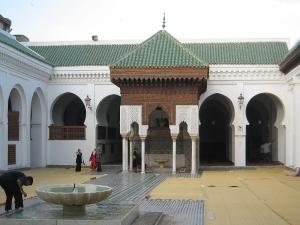Short Description
The first formal madrasa of the Muslim world, the University of al-Karaouine in Fes was established in 859 by a wealthy merchant by the name of Fatima al-Fihri.
- The first formal madrasa of the Muslim world, the University of al-Karaouine in Fes was established in 859 by a wealthy merchant by the name of Fatima al-Fihri.
- The Abbasid caliph Harun al-Rashid’s wife, Zubayda, personally funded many construction projects for mosques, roads, and wells in the Hijaz, which greatly benefit the many students that traveled through these areas.
- The wife of Ottoman Sultan Suleyman, Hurrem Sultan, endowned numerous madrasas, in addition to other charitable works such as hospitals, public baths, and soup kitchens.
- During the Ayyubid period of Damascus (1174 to 1260) 26 religious endownments (including madrasas, mosques, and religious monuments) were built by women.
Education and Women
Throughout Islamic history, educating women has been a high priority. Women were not seen as incapable of attaining knowledge nor of being able to teach others themselves. The precedent for this was set with Prophet Muhammad’s own wife, Aisha, who was one of the leading scholars of her time and was known as a teacher of many people in Madinah after the Prophet’s ﷺ death.
Later Islamic history also shows the influence of women. Women throughout the Muslim world were able to attend lectures in mosques, attend madrasas, and in many cases were teachers themselves. For example, the 12th century scholar Ibn ‘Asakir (most famous for his book on the history of Damascus, Tarikh Dimashq) traveled extensively in the search for knowledge and studied under 80 different female teachers.
Women also played a major role as supporters of education:
Unlike Europe during the Middle Ages (and even up until the 1800s and 1900s), women played a major role in Islamic education in the past 1400 years. Rather than being seen as second-class citizens, women played an active role in public life, particularly in the field of education.
Modern History
The tradition of madrasas and other classical forms of Islamic education continues until today, although in a much more diminshed form. The defining factor for this was the encroachment of European powers on Muslim lands throughout the 1800s. In the Ottoman Empire, for example, French secularist advisors to the sultans advocated a complete reform of the educational system to remove religion from the curriculum and only teach secular sciences. Public schools thus began to teach a European curriculum based on European books in place of the traditional fields of knowledge that had been taught for hundreds of years. Although Islamic madrasascontinued to exist, without government support they lost much of their relevance in the modern Muslim world.
Today, much of the former Ottoman Empire still runs education along European lines. For example, what you are allowed to major in at the university level depends on how you do on a certain standardized test at the end of your high school career. If you obtain the highest possible grades on the test, you can study sciences such as medicine or engineering. If one scores on the lower end of the spectrum, they are only allowed to study topics such as Islamic sciences and education.
Despite the new systems in place in much of the Muslim world, traditional education still survives. Universities such as al-Azhar, al-Karaouine, and Darul Uloom in Deoband, India continue to offer traditional curricula that bring together Islamic and secular sciences. Such an intellectual tradition rooted in the great institutions of the past that produced some of the greatest scholars of Islamic history and continues to spread the message and knowledge of Islam to the masses.






![نصيحتي لك: اذكر الله [1 / 12] نصيحتي لك: اذكر الله [1 / 12]](https://300035.dotdothktrade.tech/images/upload/content_thumbs/1913613138ragheb-al-serjany-videos.jpg)


Comments
Send your comment